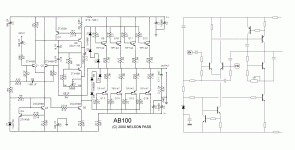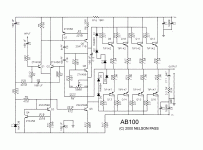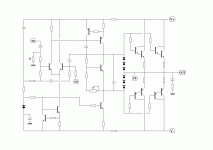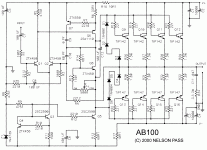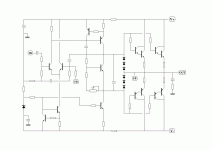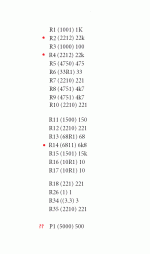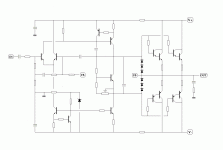Please see the thread "Bridge a pair F5s" for more detail.
ah...for bridging two stereo amps, I guess
but starting from scratch, I thought 'X-balanced' would be better 😕
well, maybe its better to go slow on the balanced subject...its still early days for this thread 😉 and it might go on for a long time
ah...for bridging two stereo amps, I guess
but starting from scratch, I thought 'X-balanced' would be better 😕
well, maybe its better to go slow on the balanced subject...its still early days for this thread 😉 and it might go on for a long time
I'll pause for the time being and wait to explain its operation.
Two threads already explain [by analogy] the operation of Conjoined Twin AB100. They are "Conjoined Twin DiyF6s" and "Bridge a pair of F5s" in the Pass Labs Forum.back to sorting out the transistors ?
Best regards.
I should think they would do the job, and fewer of them.. Of course you
don't at all have to use darlingtons. It's trivial to put together a driver stage.
😎
Trivial for YOU maybe LOL!

Not so much for us Padawans!
R2=22.1K, R4= 22.1K, R6=33.1, R8-9=4,75K, R13=68.1, R14= 6.81K, R15= 1.5K, R15-16=10.1, R34=3.3.
I will have to presume that the diode string across the bases of TIP 142 147 will shunt excessive drive to output and that will create a crude method of limiting if and when needed
I am actually not familiar how protection like that will work sound wise ...None of the amplifiers i am listening to had this schema of protection ...Also don't know how effective this is
Then the question for me is :why bother? since Darlingtons on the output will do there "own" thing after the protection depending on the thermals cooling load and so on and on .
Tinitus i think exercise is always nice and sharpens brains but i think one may put his energy on a pcb and not a schematic .
Nice idea for a weekend project could be a pcb that has the arrangement of transistors L style bracket made like NPNPDVBEDNPNP
Where
N stands for NPN
P stands for PNP
D for driver ( there can be a question if driver needs common heat sink with outs)
and VBE will be Vbe
could be nice project but not for me ...unless one has a better darlington to offer than 142 147 ( any with audio specs will do )
I presume that arrangement like that will offer excellent current sharing and equalize thermals all the way through . Point is no matter what i say the next step is to construct and listen cause i may hate darlingtons while NP operates them in an ""other" way and after all may worth listening .
Kind regards
Sakis
I am actually not familiar how protection like that will work sound wise ...None of the amplifiers i am listening to had this schema of protection ...Also don't know how effective this is
Then the question for me is :why bother? since Darlingtons on the output will do there "own" thing after the protection depending on the thermals cooling load and so on and on .
Tinitus i think exercise is always nice and sharpens brains but i think one may put his energy on a pcb and not a schematic .
Nice idea for a weekend project could be a pcb that has the arrangement of transistors L style bracket made like NPNPDVBEDNPNP
Where
N stands for NPN
P stands for PNP
D for driver ( there can be a question if driver needs common heat sink with outs)
and VBE will be Vbe
could be nice project but not for me ...unless one has a better darlington to offer than 142 147 ( any with audio specs will do )
I presume that arrangement like that will offer excellent current sharing and equalize thermals all the way through . Point is no matter what i say the next step is to construct and listen cause i may hate darlingtons while NP operates them in an ""other" way and after all may worth listening .
Kind regards
Sakis
Last edited:
A few quick answers.
The original design (this one) was intended for dummies with maximum
reliability and minimum adjustment and also minimum opportunity for
noises and pops. ....
😎
I guess that answers it .... maximum reliabity sounds good for my bass guitar... and intended for dummies, spot on too 😀
I expect to hardwire on proto board
regarding the Darlingtons
with their high current gain, I suppose they are easy to drive, and might have been chosen for that reason ?
http://www.onsemi.com/pub_link/Collateral/TIP140-D.PDF
I guess there is a first time for everything, also on Pass forum
- Home
- Amplifiers
- Pass Labs
- AB100 Class AB Power Amplifier
